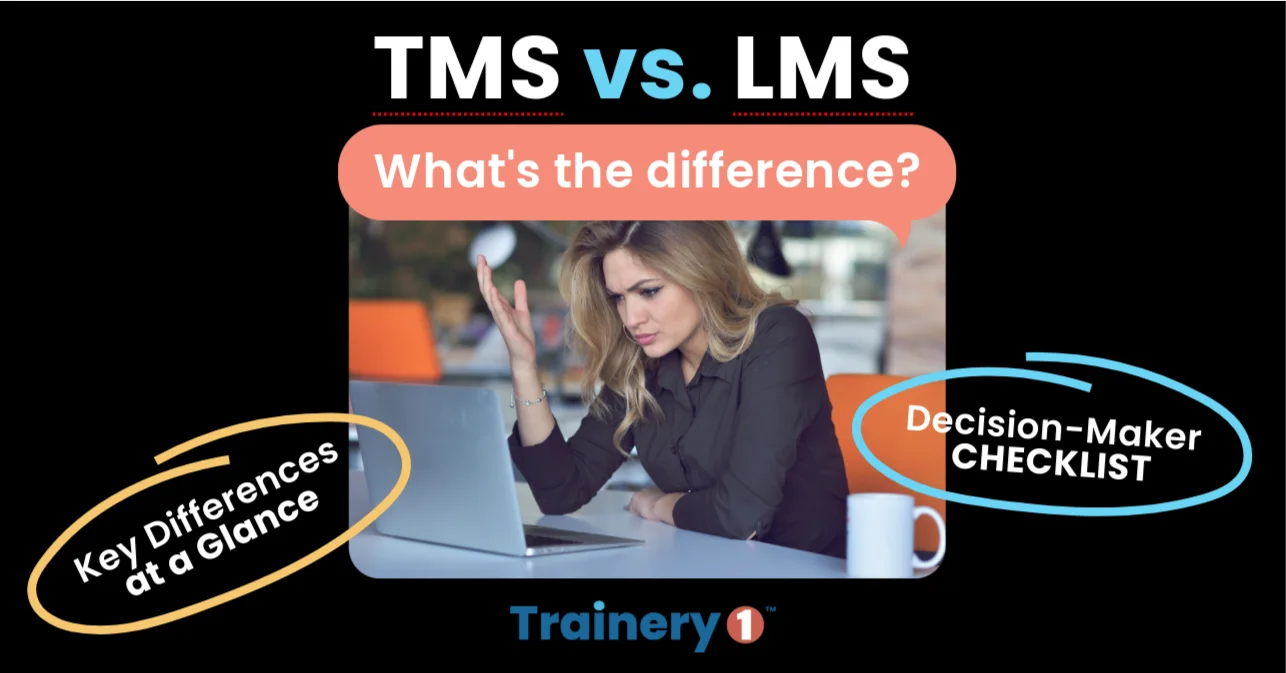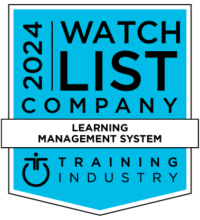Investing in the right training infrastructure is critical to driving workforce development, compliance, and performance. Two systems often at the center of this decision are the Learning Management System (LMS) and the Training Management System (TMS). While they may sound similar, these tools serve distinct purposes—and understanding the difference can help organizations make smarter, more strategic investments.
What Is a Learning Management System (LMS)?
A Learning Management System is a software platform designed to deliver, manage, and track eLearning programs. It is typically used to provide elearning administration, management, content, assignment, and delivery of learning to users who can complete their assignments when convenient instead of a designated time and location.
What Is a Training Management System (TMS)?
A Training Management System is typically used by L&D administrators and training coordinators to plan, schedule, and manage instructor-led training (ILT)—whether in person or virtual (VILT). A TMS focuses on the logistics of training operations. Often referred to as the ‘backroom’ of operations, most Training Management Systems include event management, instructor assignment, attendee registration, course materials, and compliance management.
LMS vs. TMS: What’s the Difference? Key Differences at a Glance

Choosing the Right System: Key Considerations
When deciding between an LMS and a TMS, consider your organization’s learning strategy, training delivery methods, and internal stakeholders.
- Training Delivery Mix
If your organization delivers primarily online training, an LMS will likely be the best fit. If your training is more ILT-heavy or uses blended methodologies, a TMS may better meet your needs. - Audience Size and Type
An LMS is ideal for scaling learning across large, dispersed teams. A TMS is more suited for managing complex training programs where coordination and resource allocation are critical. - Compliance Requirements
Highly regulated industries (e.g., healthcare, manufacturing, aviation) often need robust documentation and audit trails—a strength of most TMS and LMS platforms. Both platforms feature compliance management and flexible reporting structures. The difference in selection relies primarily on the learning delivery method. - Budget and Integration
An LMS typically focuses on content delivery, engagement, and learning outcomes, while a TMS can help optimize blended training programs, budgets and resource allocation. A few platforms on the market integrate L&D and employee training, in all of its shapes and forms, within a centralized platform.
You May Need Both
For many organizations, the best solution isn’t either/or—it’s both. A comprehensive learning ecosystem can leverage the strengths of both an LMS and a TMS, ensuring the organization can deliver high-impact training while efficiently managing operations behind the scenes.
Investing in the right system—or systems—requires a clear understanding of your training goals, your workforce needs, and your organizational structure. With the right approach, businesses can empower employees, increase compliance, and unlock greater ROI on every training dollar spent.
What are the benefits of using both a TMS and LMS?
Using both a Training Management System (TMS) and a Learning Management System (LMS) gives organizations a well-rounded, scalable, and efficient way to manage all aspects of learning and development. Here are the key benefits of using both systems together:
- End-to-End Training Management – By combining an LMS and a TMS, companies gain full control over all of their learning operations. The LMS delivers and manages elearning, while the TMS handles scheduling, logistics, budgeting, and resource allocation for onsite and blended programs.
- Blended Learning Made Easy – despite the trend toward online learning, most organizations don’t rely solely on one training format. With both systems, you can easily offer blended learning—a mix of self-paced online modules (via the LMS) and live, instructor-led training sessions (via the TMS), all managed from integrated platforms.
- Better Compliance and Audit Readiness – In regulated industries, combining the data from a TMS and LMS can provide seamless, comprehensive compliance tracking, audit gaps, and credential management.
- Improved Training Efficiency – An TMS automates time-consuming administrator tasks like scheduling events, enrolling participants, managing instructors, and tracking costs. When this is paired with an LMS that facilitates online course assignment, content delivery, quizzes/scoring, and learner management, trainers can focus more on strategy and less on logistics.
- Stronger Data and Insights – Together, a TMS and LMS provide a complete view of training impact. From understanding who attended what and when, to how well they performed, to how much it cost—you can analyze ROI and learning outcomes in a way that neither system offers alone.
- Scalable Learning Ecosystem – As organizations grow, so do their training needs. A combined LMS/TMS setup is flexible and scalable, making it easier to onboard new employees, upskill and reskill, manage compliance deadlines, and scale L&D and employee training programs to meet workforce needs.
- Personalized Learning and Strategic Planning – The LMS can guide learners through personalized learning paths, while the TMS helps administrators plan operationally—forecasting training demand, tracking resource availability, and budgeting effectively.
- Enhanced Employee Experience – When used together, these systems support a seamless learner journey: easy access to digital learning, clear visibility into upcoming sessions, automatic reminders, and activity tracking—all of which increase engagement, completion, and compliance.
Here’s a decision-makers’ checklist to help determine whether your organization could benefit from using both a Learning Management System (LMS) and a Training Management System (TMS):
LMS + TMS Decision-Maker Checklist
Training Strategy & Delivery
We offer both self-paced digital learning and instructor-led training (in-person or virtual)
Our organization uses blended learning programs (e.g., leadership, onboarding, compliance)
We need to scale learning across multiple teams, regions, or departments
System Capabilities
We want to deliver and track eLearning content and certifications
We need to schedule and manage ILT/onsite & virtual sessions and track attendance
We require robust reporting on both learning outcomes and training logistics
Operational Efficiency
We need to reduce mistakes and improve workflow efficiency when managing training activities.
We want to automate registration, reminders, and tracking for training events
We need visibility into training budgets, resource allocation, and instructor usage
Data, Compliance & Reporting
We must meet regulatory compliance requirements with thorough training records
We need audit-ready reports on both eLearning and ILT/VILT completions
We want to assess training outcomes and learner performance in one place
Growth & Scalability
We need a system that can scale with the business
We want to offer custom learning paths while managing program logistics efficiently
We aim to provide a seamless, engaging learner experience that boosts participation
If you checked 6 or more boxes…
Your organization is likely ready for an integrated LMS + TMS solution. Together, they will support a more strategic, efficient, and scalable training program.
While either system can bring significant value on its own, the real power comes from integration. Businesses that use both a TMS and LMS gain the agility to manage complex learning programs with precision and deliver impactful training experiences that fuel employee growth and organizational performance.








